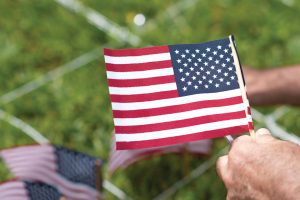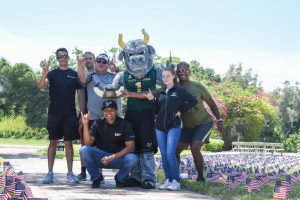The Connector
Kathy Black uses research and relationships to help build a community for all ages in Sarasota
Gerontologist Kathy Black, PhD, says aging is being rewritten before our eyes.
“We are in the midst of a great demographic transition,” said Black, a professor of aging studies at USF Sarasota-Manatee. “The entire world is aging, but in Sarasota we have already been living with a large aging population for many years.”
Nationally, about 13 percent of the population is 65 or older. In Sarasota, that number is 33 percent, and the median age is 54.
“Being here is a gerontologist’s dream,” said Black, who considers Sarasota the right place at the right time in her 40-year career that began in nursing. “It’s incredibly unique to live and work in a community with such a high percentage of older adults.”
"This work was really about listening to people. We assessed what community features are most helpful to people as they age."
After her arrival in 2002, Black wasted no time getting involved on campus and in the community. In fact, in local civic and educational initiatives to promote healthful aging, Black is Sarasota’s common denominator.
Black spearheaded Age-Friendly Sarasota, an initiative that propelled Sarasota County to join the Age-Friendly Community network of the World Health Organization (WHO). Sarasota is Florida’s first community to join, due in large part to Black’s leadership and support from The Patterson Foundation.
For the first phase of the project, Black engaged about 1,200 residents through surveys and focus groups in every ZIP code in the county to ensure all areas were represented.
“This work was really about listening to people,” Black said. “We assessed what community features are most helpful to people as they age.”
Based on the results of the surveys and focus groups, Black helped to develop an action plan that provides specific goals for the community across eight domains:
- Outdoor spaces and public buildings
- Transportation
- Housing
- Social participation
- Respect and social inclusion
- Civic participation and employment
- Communication and information
- Community support services
Black said the WHO recognizes that communities differ. In Sarasota, for example, social programming is abundant.
“We have so much programming – cognitive, social, physical, recreational. We are so rich,” Black said. “But in our study, we heard a lot about the built environment, including transportation.”


Kathy Black speaks with a group of students
Black reached out to the Metropolitan Planning Organization, or MPO, a regional transportation planning group, about engaging USF students to carry out walkability studies using a smartphone app. As the students walk, they capture image and GIS data of potholes, gaps in sidewalks and other issues that complicate life for pedestrians. Work with the MPO also includes policy efforts to ensure the needs of older citizens are considered when developing walking, cycling and driving infrastructures.
Alternatives to automobile travel are important, considering that older adults outlive their ability to drive safely by seven to 10 years, Black said. Sarasota has an Independent Transportation Network (ITN) offering door-to-door service for people 60 or older, and that’s important for getting to medical appointments and running errands.
But older residents said they want more from transportation. Black advised a group of USF Sarasota-Manatee campus MBA students who used their capstone project to look at transportation for older residents from a different angle.
“The perspective of the students was, ‘How do we make transportation fun?’” Black said. “Their model included a party bus and a calendar of events.” ITN has since implemented the students’ program, which is being piloted for feasibility as a national model.
"When you make a community better for people who are older, you are making it better for people of all ages."
Sarasota’s civic groups rely on a legion of volunteers – Black said some local organizations have hundreds of volunteers.
“Though Sarasota is a shining star when it comes to volunteering, there is increasing interest in strengthening the relationships between the generations in Sarasota County, which has a disproportionately lower share of millennial-aged adults,” Black said.
Black notes that promoting a multigenerational workforce can, for example, encourage younger workers to mentor up to older workers, teaching them new tech skills needed in today’s workplace.
With her sweeping view of aging, from teaching college students to conducting research on aging, Black is uniquely positioned to discuss what being “age-friendly” really means. In her Physical Changes in Aging class she simulates sensory changes with aging such as vision and hearing loss. She said her students report back about better understanding older customers and clients in their work and with their families.
“The students recognize that eyesight or hearing can interfere with communication,” she said. “That leads to age-friendly service for organizations in our community.”
Black is particularly enthusiastic about the far-reaching policy implications of the age-friendly work in the region. For example, Sarasota County has adopted a voluntary resolution for builders to design homes with universal features such as wider doorways to accommodate wheelchairs or grab bars in bathrooms.
Black, who was recognized as a 2017 Next Avenue Top 50 National Influencer in Aging, has also partnered with AARP Florida and other age-friendly movements across the state and nation. Recently, she was invited to help draft policy about creating an age-friendly public health system for the American Public Health Association.
Ultimately, age-friendly communities benefit everyone, she said.
“When you make a community better for people who are older, you are making it better for people of all ages,” Black said. “Everybody is a stakeholder in an aging society.”


SUBSCRIBE TO
Research: USF Sarasota-Manatee Campus
Subscribe to our digital Research Magazine and full access to online content and e-Alerts
What questions should we ask of an age-friendly community?
Outdoor spaces and public buildings:
Are parks, parking lots, shopping venues and government centers safe, accessible and barrier-free?
Transportation:
Do residents have access to reliable, affordable transportation? Is the design of traffic-related infrastructure – signs, traffic lights, sidewalks – helpful to drivers and pedestrians of all ages?
Housing:
Is housing affordable, well-located and designed in a manner that allows for independent living? Are there options for shared or communal housing?
Social participation:
Does the community promote a variety of interactions that allow citizens of all abilities and financial means to participate in community activities?
Respect and social inclusion:
Does the community foster intergenerational understanding and respect for aging persons, as well as positive images of aging?
Civic participation and employment:
Are there ample opportunities for volunteering, voting, serving on committees, as well as opportunities for meaningful employment?
Communication and information:
Are all citizens connected to sources of communication about events and services?
Community support services:
Are support services available for mental and physical health across the lifespan, including services for those who serve as caregivers?
More reading:



